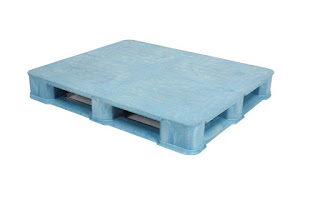Plastic Pallet
- Get link
- X
- Other Apps
Plastic Pallet
 |
Plastic Pallet |
Top
Flat Hygiene Pallet is suitable for food and pharmaceutical
manufacturing lines. Size available: 1200x1000x160mm , 1200x1200x160mm
or 1300x1100x160mm
Unlike wood pallets, there are many processes that exist to manufacture plastic pallets. All have their costs and benefits. Process factors into pallet performance, volume, standardization, and cost.
Injection molded pallets offer quality dimensions and high impact resistance from fork tine abuse. A cost to injection molded pallets is that you must be looking for a fairly standard type of pallet. If the pallet is unique, more than likely a manufacturer will not invest in the equipment to make it, since it’s not a design they’ll be likely to implement often. In order to justify the investment, orders must typically exceed 50,000 units. Keep in mind that this is a general guideline, and not a hard-and-fast rule.
Structural foam is manufactured under lower pressure than injection molding, and uses gas in the process, rendering the inside of the plastic part porous instead of solid. This porosity allows for more rigid platforms (imagine thousands of bridges inside the plastic) making structural foam a good option for ensuring high weight capacity in racking.
The trade-off is that the porosity renders the plastic more susceptible to damage at impact. When hit with force, pallets made from structural foam will chunk off in pieces. This is a problem for sensitive operations that can’t afford to have foreign particles introduced.
During thermoforming, sheet plastic is heated to a nearly liquid form, and then pulled down into a mold where it is vacuum formed into the space. Nestable pallet concepts were developed using the thermoform process.
A nice benefit of thermoformed plastic is that it is malleable and takes fork tine abuse well. Conversely, being the most flexible plastic of those mentioned, thermoformed plastic pallets don’t perform well in heavy weight environments.
Manufacturing process has a major impact on pallet cost and performance, and is an important factor to consider when choosing the right plastic pallet for your application.
Unlike wood pallets, there are many processes that exist to manufacture plastic pallets. All have their costs and benefits. Process factors into pallet performance, volume, standardization, and cost.
Injection Molding
High performance pallets are usually injection molded. Most injection molding is done using virgin or high-quality reprocessed resin. Injection molding is expensive, but it’s also the highest speed process, and pallets can be made very quickly once the mold goes to press. Due to these factors, it makes sense to choose injection molding when ordering a large volume of pallets. Most large orders or standardized orders are injection molded.Injection molded pallets offer quality dimensions and high impact resistance from fork tine abuse. A cost to injection molded pallets is that you must be looking for a fairly standard type of pallet. If the pallet is unique, more than likely a manufacturer will not invest in the equipment to make it, since it’s not a design they’ll be likely to implement often. In order to justify the investment, orders must typically exceed 50,000 units. Keep in mind that this is a general guideline, and not a hard-and-fast rule.
Structural Foam Molding
Structural foam molding is another process that is widely used for manufacturing plastic pallets because it is a process that costs less than injection molding, while offering many of the same benefits.Structural foam is manufactured under lower pressure than injection molding, and uses gas in the process, rendering the inside of the plastic part porous instead of solid. This porosity allows for more rigid platforms (imagine thousands of bridges inside the plastic) making structural foam a good option for ensuring high weight capacity in racking.
The trade-off is that the porosity renders the plastic more susceptible to damage at impact. When hit with force, pallets made from structural foam will chunk off in pieces. This is a problem for sensitive operations that can’t afford to have foreign particles introduced.
Thermoforming
A third process is thermoforming. Thermoforming is a much cheaper process than both injection molding and structural foam molding.During thermoforming, sheet plastic is heated to a nearly liquid form, and then pulled down into a mold where it is vacuum formed into the space. Nestable pallet concepts were developed using the thermoform process.
A nice benefit of thermoformed plastic is that it is malleable and takes fork tine abuse well. Conversely, being the most flexible plastic of those mentioned, thermoformed plastic pallets don’t perform well in heavy weight environments.
Other Processes
There are various other processes used to make plastic pallets such as rotational molding, compression molding, extrusion/assembly and blow molding. These processes are not as common in the market but can be very efficient depending on the part being made. They are usually considered at very low volumes.Manufacturing process has a major impact on pallet cost and performance, and is an important factor to consider when choosing the right plastic pallet for your application.
- Get link
- X
- Other Apps

